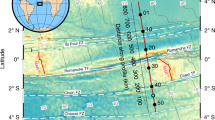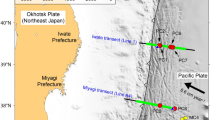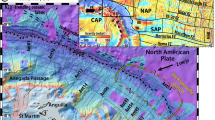Abstract
Water and hydrous minerals play a key part in geodynamic processes at subduction zones1,2,3 by weakening the plate boundary, aiding slip and permitting subduction—and indeed plate tectonics—to occur4. The seismological signature of water within the forearc mantle wedge is evident in anomalies with low seismic shear velocity marking serpentinization5,6,7. However, seismological observations bearing on the presence of water within the subducting plate itself are less well documented. Here we use converted teleseismic waves to obtain observations of anomalously high Poisson’s ratios within the subducted oceanic crust from the Cascadia continental margin to its intersection with forearc mantle. On the basis of pressure, temperature and compositional considerations, the elevated Poisson’s ratios indicate that water is pervasively present in fluid form at pore pressures near lithostatic values. Combined with observations of a strong negative velocity contrast at the top of the oceanic crust, our results imply that the megathrust is a low-permeability boundary. The transition from a low- to high-permeability plate interface downdip into the mantle wedge is explained by hydrofracturing of the seal by volume changes across the interface caused by the onset of crustal eclogitization and mantle serpentinization. These results may have important implications for our understanding of seismogenesis, subduction zone structure and the mechanism of episodic tremor and slip.
This is a preview of subscription content, access via your institution
Access options
Subscribe to this journal
Receive 51 print issues and online access
We are sorry, but there is no personal subscription option available for your country.
Buy this article
- Purchase on Springer Link
- Instant access to full article PDF
Prices may be subject to local taxes which are calculated during checkout



Similar content being viewed by others
References
Peacock, S. M. Fluid processes in subduction zones. Science 248, 329–337 (1990)
Stern, R. J. Subduction zones. Rev. Geophys. 40 10.1029/2001RG000108 (2002)
Kirby, S. H., Engdahl, E. R. & Denlinger, R. in Subduction Top to Bottom (eds Bebout, G. E., Scholl, D. W., Kirby, S. H. & Platt, J. P.) 195–214 (Am. Geophys. Un., 1996)
O’Neill, C., Jellinek, A. M. & Lenardic, A. Conditions for the onset of plate tectonics on terrestrial planets and moons. Earth Planet. Sci. Lett. 261, 20–32 (2007)
Hyndman, R. D. & Peacock, S. M. Serpentinization of the forearc mantle. Earth Planet. Sci. Lett. 212, 417–432 (2003)
Bostock, M. G., Hyndman, R. S., Rondenay, S. & Peacock, S. M. An inverted continental Moho and serpentinization of the forearc mantle. Nature 417, 536–539 (2002)
Kawakatsu, H. & Watada, S. Seismic evidence for deep-water transportation in the mantle. Science 316, 1468–1471 (2007)
Kao, H. et al. A wide depth distribution of seismic tremors along the northern Cascadia margin. Nature 436, 841–844 (2005)
Shelly, D. R., Beroza, G. C. & Ide, S. Low-frequency earthquakes in Shikoku, Japan, and their relationship to episodic tremor and slip. Nature 442, 488–491 (2006)
Wang, Z., Zhao, D., Mishra, O. P. & Yamada, A. Structural heterogeneity and its implications for the low frequency tremors in Southwest Japan. Earth Planet. Sci. Lett. 251, 66–78 (2006)
Nicholson, T., Bostock, M. G. & Cassidy, J. F. New constraints on subduction zone structure in northern Cascadia. Geophys. J. Int. 161, 849–859 (2005)
Yuan, X. et al. Subduction and collision processes in the central Andes constrained by converted seismic phases. Nature 408, 958–961 (2000)
Abers, G. A., van Keken, P. E., Kneller, E. A., Ferris, A. & Stachnik, J. C. The thermal structure of subduction zones constrained by seismic imaging: Implications for slab dehydration and wedge flow. Earth Planet. Sci. Lett. 241, 387–397 (2006)
Zandt, G. & Ammon, C. J. Continental crust composition constrained by measurements of crustal Poisson’s ratio. Nature 374, 152–154 (1995)
Zhu, L. & Kanamori, H. Moho depth variation in southern California from teleseismic receiver functions. J. Geophys. Res. 105, 2969–2980 (2000)
Christensen, N. I. Poisson’s ratio and crustal seismology. J. Geophys. Res. 101, 3139–3156 (1996)
Christensen, N. I. Serpentinites, peridotites, and seismology. Int. Geol. Rev. 46, 795–816 (2004)
Rondenay, S., Abers, G. A. & van Keken, P. E. Seismic imaging of subduction zone metamorphism. Geology 36, 275–278 (2008)
Moore, J. C. & Vrolijk, P. Fluids in accretionary prisms. Rev. Geophys. 30, 113–135 (1992)
Christensen, N. I. Pore pressure and oceanic crustal seismic structure. Geophys. J. R. Astron. Soc. 79, 411–423 (1984)
Kodaira, S. et al. High pore fluid pressure may cause silent slip in the Nankai Trough. Science 304, 1295–1298 (2004)
Gerver, M. & Markushevitch, V. Determination of a seismic wave velocity from the travel time curve. Geophys. J. R. Astron. Soc. 11, 165–173 (1966)
Wielandt, E. in Seismic Tomography (ed. Nolet, G.) 85–98 (Reidel, 1987)
Fisher, A. T. Permeability within basaltic oceanic crust. Rev. Geophys. 36, 143–182 (1998)
Caine, J. S., Evans, J. P. & Foster, C. B. Fault zone architecture and permeability structure. Geology 24, 1025–1028 (1996)
Kato, A., Sakaguchi, A., Yoshida, S. & Mochizuki, H. Permeability measurements and precipitation sealing of basalt in an ancient exhumed fault of a subduction zone. Bull. Earthq. Res. Inst. Univ. Tokyo 78, 83–89 (2003)
Meneghini, F. & Moore, J. C. Deformation and hydrofracturing in a subduction thrust at seismogenic depths: The Rodeo Cove thrust zone, Marin Headlands, California. Geol. Soc. Am. Bull. 119, 174–183 (2007)
Ramachandran, K., Dosso, S. E., Spence, G. D., Hyndman, R. D. & Brocher, T. M. Forearc structure beneath southwestern British Columbia: A three-dimensional tomographic velocity model. J. Geophys. Res. 110, B02303 (2005)
Ahrens, T. J. & Schubert, G. Gabbro–eclogite reaction rate and its geophysical significance. Rev. Geophys. 13, 383–400 (1975)
Coleman, R. G. Petrologic and geophysical nature of serpentinites. Geol. Soc. Am. Bull. 82, 897–918 (1971)
Acknowledgements
We thank E. Davis and M. Jellinek for discussions. Data used in this study come from the Canadian National Seismological Network and are distributed freely by the Geological Survey of Canada.
Author Contributions P.A. and M.G.B. designed the study, analysed the data and wrote the paper; N.I.C. and S.M.P. participated in the interpretation of results.
Author information
Authors and Affiliations
Corresponding author
Supplementary information
Supplementary Information
This file contains Supplementary Data, Supplementary References and Supplementary Figures S1-S7 with Legends (PDF 509 kb)
Rights and permissions
About this article
Cite this article
Audet, P., Bostock, M., Christensen, N. et al. Seismic evidence for overpressured subducted oceanic crust and megathrust fault sealing. Nature 457, 76–78 (2009). https://doi.org/10.1038/nature07650
Received:
Accepted:
Issue Date:
DOI: https://doi.org/10.1038/nature07650
This article is cited by
-
Detections of ultralow velocity zones in high-velocity lowermost mantle linked to subducted slabs
Nature Geoscience (2024)
-
Coseismic fault sealing and fluid pressurization during earthquakes
Nature Communications (2023)
-
In situ Rb–Sr and 40Ar–39Ar dating of distinct mica generations in the exhumed subduction complex of the Western Alps
Contributions to Mineralogy and Petrology (2023)
-
Crack growth behavior and failure prediction for a granite under compressive fatigue
Mechanics of Time-Dependent Materials (2023)
-
Orogenic gold: is a genetic association with magmatism realistic?
Mineralium Deposita (2023)
Comments
By submitting a comment you agree to abide by our Terms and Community Guidelines. If you find something abusive or that does not comply with our terms or guidelines please flag it as inappropriate.



